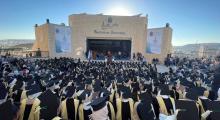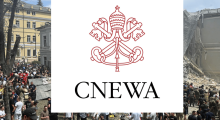Issued by the Catholic Center for Studies and Media - Jordan. Editor-in-chief Fr. Rif'at Bader - موقع أبونا abouna.org

On the morning of Saturday 8 February, the Custos of the Holy Land, Fra Francesco Patton, presided over the Mass in the “Crusader Chapel” of the Holy Sepulcher, at the end of the restoration. During the celebration, he blessed the new altar and the throne. He then also blessed the new wing of the Franciscan convent, at the end of the restoration work.
“With the bull Gratias agimus of 21 November 1342. Pope Clement VI asked us three things, the first of which was to live in the Holy Places,” the Custos emphasized in his homily. “The aim of the convent in the Sepulcher is exactly that of implementing the Pope’s instruction to live in the Holy Sepulcher, so that this is a living place and not a museum.” The second element of the mandate is that of “celebrating sung masses and divine offices” in the Holy Places. “We who live and breathe here give shape and voice to the whole of humanity, who need to draw on the Paschal mystery which is the vital lymph of hope.”
The restyling of the Crusader Chapel
The “Crusader Chapel” is a liturgical space in the Franciscan convent of the Holy Sepulcher, which is reached from the sacristy or from the Chapel of the Apparition. It has a single nave, with exposed stone, divided into two by a wall in which an arch opens. It is one of the places of Catholic worship in the Holy Sepulcher which, together with the Chapel of the Apparition and the Altar of Mary Magdalene, put at the disposal of the pilgrims for celebrations (it can host about 80 people).
The restoration, begun in the spring of 2023 and concluded one year later, “concerned the lighting and the ventilation of the areas and the problems of infiltration of water,” Fra Stéphane Milovitch, President of the Holy Sepulcher explained. In addition, “there were also a new altar, a new throne and a new ambo.”
The altar (a stone slab which rests on a base of a column from the Constantinian basilica) was moved forwards. “This,” Fr Stéphane explained, “has allowed making the space behind the arch usable, bringing back to the light some oil- presses, already identified by Virgilio Corbo”. On their return, “the pilgrims will find a renewed area and will also be able to enjoy a part, that of the oil presses, which until then had not been visible.”
Living in the Holy Sepulcher
The Franciscan community has had a stable presence in the Holy Sepulcher for almost 700 years and has guaranteed an almost uninterrupted service, which also includes celebrations at night and shifts which keep the sacristans busy until 4 in the morning.
At the moment the fraternity is made up of 11 friars; the organist and the cantor stay overnight when there are nocturnal liturgies, as access to the basilica is not possible after 7:00pm.
Until the middle of the 19th century, the friars almost had to camp out in the gallery that looks on to the Rotonda of the Anastasis. Emperor Franz Joseph of Austria, a pilgrim to the Holy Land in 1869, financed the building of the small convent which was renovated in the 1960s, with significant critical points, including the absence of windows and poor hygienic services.
It has only been in the last three years, thanks to a huge sum donated by the American benefactor William Keifer (whose name appears on a plaque at the entrance to the convent), through the Franciscan Foundation for the Holy Land (FFHL), that it has been possible to renew one wing of the convent, building 9 rooms to let the friars enjoy adequate space. Another five rooms and common areas are waiting to be restored.
Investing in the Holy Places
In times of war and the (consequent) economic crisis due to the block of pilgrimages, renovating the Crusader Chapel and the convent of the Holy Sepulcher take on a particular meaning, the Custos underscored. First of all, it allowed “giving work” to the workers and “an income and decent life” to their families.
Secondly, “it reminds Christians all over the world that these places are at the basis of the story of the Salvation: they tell us what the Son of God did for us, becoming one of us and giving his life for us. Our faith is not based on a vague theory or gnosis, but on a historical fact.”
Lastly, this work is an investment “for the benefit of the pilgrims,” who will find welcoming places, which help them dwell in prayer and relate to the mystery of the life of Jesus.
“We invite the pilgrims to come: The Holy Places are safe. Come,” is the call of the Custos, “because the pilgrimage helps strengthen the faith and make the Christians of the Holy Land feel less alone. In addition, the pilgrims are a factor of stability: by simply coming here, the pilgrims encourage peace.”







